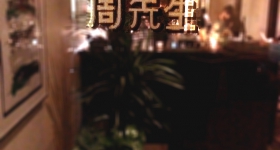One morning, after noticing my tin lunchbox, a coworker exclaimed, “Hey, a lot of people use that lunchbox in India! It’s called a tiffin.” My tiffin is a conversation starter, sparking many an unexpected, pleasant conversation with friends and strangers alike. Some notice it because they’ve never seen one. Others — mostly older South Asian immigrants — are surprised to see a non-Indian woman carrying an item they associate with office workers in India. The fictional 2013 movie “The Lunchbox” highlights Mumbai’s ubiquitous lunch delivery system in which couriers pick up tiffins and deliver them to offices.
When I was a child in Burma (now called Myanmar), my father packed a tiffin every day. At the intersection of South and Southeast Asia, Burma’s culinary traditions overlap with both regions. There are iconic Burmese dishes, like “lepek” (pickled tea leaf), “mohinga” (fish chowder), and “ohno kaukswe” (coconut noodle soup). Other Burmese dishes are less unique but reflective of Burma’s location at this crossroad. Like the food of Thailand, Laos, and Cambodia, Burmese cuisine involves gallons of fish sauce (my love for which caused my failure as a vegetarian) and heaps of fermented and dried shrimp. Like the Thai and Vietnamese, we take our tea and coffee with a dollop of condensed milk.
Other Burmese dishes are reminiscent of South Asian cuisine. The Burmese word for potato is “aloo” and “gobi” is our word for cauliflower, like in Hindi. We have samusas (smaller, triangular versions of South Asian “samosas”), curries rich with spices like turmeric, masala and chili, and desserts like “falooda” (a rose milk float, altered with Southeast Asian touches like tapioca pearls and agar agar) and “malaing lone” (soft, sweet balls of cheese floating in syrup, called “rasmalai” in various South Asian dialects). When the New York Times posted a recipe for rasmalai-inspired cardamom cream cake, I made it immediately because it reminded me of my mom’s “malaing lone.”
When my dad came home from work in Burma, I loved to play with his tiffin. We left the country when I was four, and I’m not sure I saw a tiffin again. I probably wouldn’t even remember what one is, except my parents had a picture of me as a toddler pacing our veranda clutching my dad’s tiffin. Inspired by this picture, my husband bought me a tiffin for Christmas, and I’ve brought my lunch in it since. I didn’t know many Burmese people growing up. However, I have always enjoyed Burmese food as a connection to my ethnicity and culture. My tiffin is a tangible reminder of Burma’s culinary traditions and practices.
My own Burmese dishes are aspirational at best. My early attempts at Burmese food were downright dismal. In college, I attempted to make “senwimakin” (semolina cake) for my boyfriend’s family. I didn’t add enough water and it turned hard as a rock. These days, I’ve figured out how to make a mean ginger salad (a crunchy, tangy mixture composed mostly of pickled ginger, peanuts, sesame, dried shrimp, fried garlic, crunchy yellow peas, fish sauce, and lime) and now serve a passable “senwimakin” (after working out the kinks in that recipe) to my kids’ friends.
Living in San Francisco in the ’90s, I learned of a network of women peddling authentic Burmese treats out of their home kitchens. One lady sold “samusas,” another sold “platha” (a buttery, flakey flatbread that’s a cross between a croissant and nan bread, also called “paratha”). These women catered every party I hosted in my ’20s. After calling in an order a couple days earlier, I would pull up to a nondescript suburban driveway to a garage smelling of fried goodness. Five minutes later, I would walk out laden with foil trays of Burmese appetizers ready to feed my hungry guests.
About 10 years ago, strolling around San Francisco, my mom and I happened upon a Burmese jewelry shop. The storefront offered Burmese jewels, tapestries, statues and other handicrafts. More importantly for our purposes, tucked away in a back room was a cornucopia of Burmese groceries. Instant “mohinga” and “lepek,” fermented shrimp, tamarind, deep friend yellow peas, “balachaung” (dried shrimp fried with chili, garlic and spices), and last but not least, durian candy. Durian is a sweet, custardy fruit and a pungent sulfuric aroma. I despise durian — the Burmese part of me keeps giving that candy another chance, but I should probably just throw in the towel.
The once miniscule Burmese community has become more visible in the United States, with children of earlier immigrants coming of age at precisely the same time that new refugee populations are ballooning in unlikely places like Fort Wayne, Indiana, and Utica, New York. According to the Census, the United States had just over 146,000 people in 2015 with origins in Burma (representing diverse ethnic groups like Karen, Chin and others, as well as individuals of Chinese and South Asian descent). That may not seem like much, but it has expanded by almost 50% since 2010 (when there were just over 100,000 of us). As our community grows, there’s been a palpable uptick of interest in Burmese cuisine. Burmese-inspired recipes have appeared in cookbooks, and Burmese restaurants have multiplied. My hometown of Palo Alto, California now boasts three Burmese restaurants.
In New York City, where I now live, for years the only Burmese restaurants were the reliable stalwart Café Mingala in the Upper East Side, and its now closed downtown sister Village Mingala. In the last couple of years, some fresh new options have emerged. I recently ate at Burma Noodle, a popup Burmese food operation which has tabled at the popular local food fair Smorgasburg and is currently located at the Industry City Food Hall. I sampled their “samusas,” garlic rice noodles with spicy fish cakes, and coconut curry noodles, all of which were tasty but initially didn’t strike me as authentic. However, when I doused my leftovers with a healthy dose of fish sauce and lime at home, I was transported to Burma. Another, more mysterious operation called Lucky Number, surely overrun by millennial hipsters, is a roving Brooklyn popup. I’ve received notices from Lucky Number about events serving $50 five course tasting menus, which depending on your perspective is either a total rip-off or quite a deal. Unfortunately, the timing hasn’t lined up for me to attend yet, but soon I’m going to give one of their installments a spin.
This may be wishful thinking, but with some luck we may be on the verge of a Burmese food moment — or at least an initial foothold for certain Burmese dishes within the broad patchwork of American ethnic cuisine. I’m wondering how long it will be until someone notices my tiffin and says, “A lot of people use that lunchbox in Burma.”










Comments